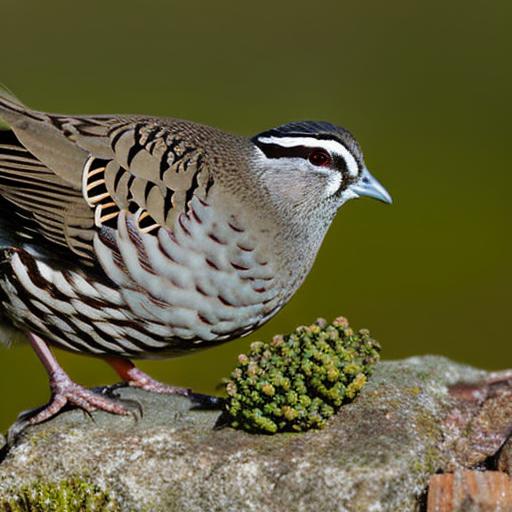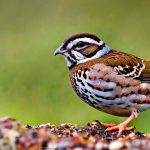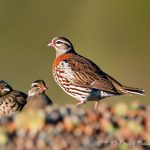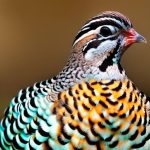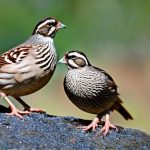The California Quail, also known as the Valley Quail, is a small ground-dwelling bird native to the western United States. These charming birds are known for their distinctive teardrop-shaped plume on their heads, as well as their intricate and beautiful feather patterns. California Quail are popular among bird enthusiasts and are often kept as pets due to their friendly and sociable nature.
California Quail are known for their distinctive “chi-ca-go” call, which can often be heard in the early morning and evening hours. They are social birds that prefer to live in small flocks and are often seen foraging for food on the ground. In the wild, they can be found in a variety of habitats, including grasslands, woodlands, and chaparral areas. They are also known for their ability to adapt to urban environments, making them a common sight in suburban areas.
These birds are relatively easy to care for and can make wonderful pets for those who have the space and resources to provide for their needs. With the right care and attention, California Quail can live for up to 5 years in captivity, making them a long-term commitment for potential owners.
Key Takeaways
- California Quail are popular game birds known for their distinctive appearance and pleasant calls.
- Before keeping California Quail as pets, it’s important to be aware of the legal considerations and regulations in your area.
- When housing California Quail, provide a spacious enclosure with plenty of hiding spots and perches to mimic their natural habitat.
- A balanced diet for California Quail includes a mix of seeds, grains, and insects to ensure proper nutrition.
- Regular health check-ups and access to a qualified avian veterinarian are essential for maintaining the well-being of California Quail in captivity.
- Breeding California Quail requires careful monitoring of nesting behavior and providing a suitable environment for successful reproduction.
- Tips for keeping California Quail as pets include providing a stress-free environment, socializing them from a young age, and ensuring they have access to dust baths for grooming.
Legal Considerations for Keeping California Quail
Before deciding to keep California Quail as pets, it is important to be aware of the legal considerations involved. In many areas, it is illegal to keep wild birds as pets without the proper permits and licenses. It is crucial to research the local laws and regulations regarding the keeping of California Quail before bringing them into your home.
In some cases, it may be necessary to obtain a permit from the appropriate wildlife or conservation agency in order to legally keep California Quail. These permits may come with specific requirements for housing, care, and record-keeping, so it is important to be prepared for the responsibilities that come with keeping these birds.
Additionally, it is important to consider the ethical implications of keeping wild birds as pets. California Quail are social animals that thrive in small flocks, so it is important to provide them with appropriate socialization and enrichment in captivity. It is also important to ensure that any birds kept as pets are obtained from reputable sources and not taken from the wild, as this can have a negative impact on wild populations.
Housing and Enclosure Requirements for California Quail
When keeping California Quail as pets, it is essential to provide them with a suitable housing and enclosure that meets their specific needs. These birds require a spacious outdoor aviary or enclosure that allows them to forage, dust bathe, and fly short distances. The enclosure should be secure and predator-proof, with a solid roof to protect the birds from aerial predators.
The flooring of the enclosure should be covered with a substrate such as sand or straw to allow the quail to engage in natural behaviors such as scratching and dust bathing. Providing natural perches and hiding spots within the enclosure can also help to create a stimulating environment for the birds.
It is important to provide access to fresh water at all times, as well as shelter from extreme weather conditions. In colder climates, heated shelters or insulated enclosures may be necessary to protect the birds from freezing temperatures. Additionally, providing access to natural vegetation and insect-rich areas within the enclosure can help to meet the quail’s dietary and behavioral needs.
Feeding and Nutrition for California Quail
Proper nutrition is essential for the health and well-being of California Quail kept as pets. These birds are omnivorous and require a varied diet that includes a combination of seeds, grains, fruits, vegetables, and insects. Commercial game bird feed can also be provided as a staple part of their diet, but it is important to supplement this with fresh foods to ensure they receive all the necessary nutrients.
In addition to a balanced diet, it is important to provide access to grit or small stones, which the quail will use to help grind up their food in their gizzards. Fresh water should always be available, either through a shallow dish or a water dispenser that allows the birds to drink easily.
It is important to monitor the quail’s food intake and adjust their diet as needed based on their activity level, age, and overall health. Providing a varied diet and ensuring access to fresh water will help to keep California Quail healthy and thriving in captivity.
Health and Veterinary Care for California Quail
Like all pets, California Quail require regular health monitoring and veterinary care to ensure they remain healthy and free from disease. It is important to find a veterinarian with experience in avian medicine who can provide routine check-ups and medical care as needed.
Common health issues in California Quail include respiratory infections, parasites, and injuries from predators or other birds. Regular observation of the quail’s behavior and appearance can help identify any potential health concerns early on.
In addition to regular veterinary care, it is important to provide a clean and sanitary living environment for the quail. Regular cleaning of the enclosure, providing fresh water daily, and removing any uneaten food can help prevent the spread of disease and parasites.
Breeding and Reproduction of California Quail
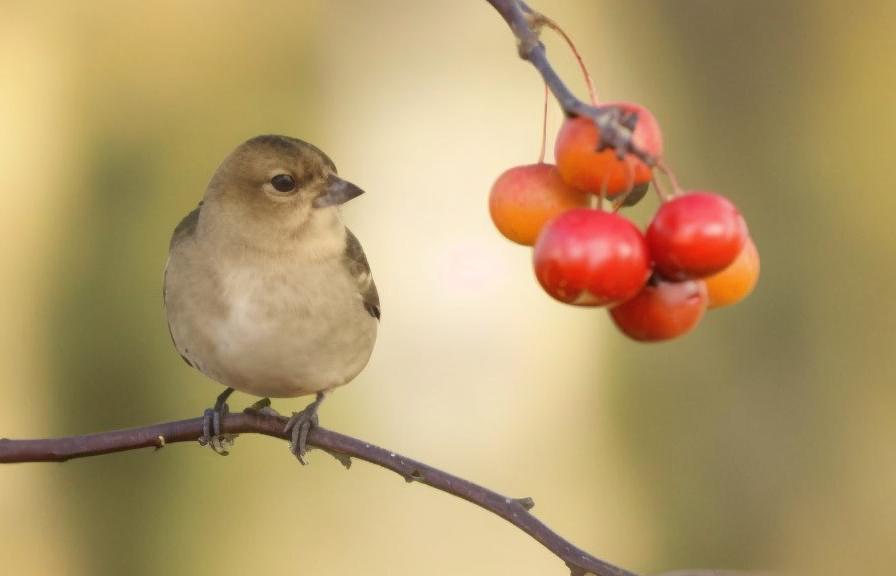
Breeding California Quail in captivity can be a rewarding experience for bird enthusiasts. These birds are monogamous and form strong pair bonds during the breeding season. To encourage breeding behavior, it is important to provide a suitable nesting area within the enclosure, such as a shallow depression lined with soft materials.
During the breeding season, female quail will lay a clutch of eggs in the nest, which they will then incubate for approximately 21 days. It is important to provide a quiet and secure environment for the nesting pair during this time to minimize stress and disturbances.
Once the eggs hatch, the parents will care for the chicks until they are old enough to fend for themselves. Providing access to natural foods such as insects and small seeds can help support the growth and development of the young quail.
It is important to be prepared for the responsibilities of caring for young quail if breeding is successful. This includes providing appropriate housing for the growing chicks and ensuring they receive proper nutrition and veterinary care as needed.
Tips for Keeping California Quail as Pets
Keeping California Quail as pets can be a rewarding experience for bird enthusiasts, but it is important to be prepared for the responsibilities that come with caring for these birds. Here are some tips for keeping California Quail as pets:
1. Provide a spacious outdoor enclosure with plenty of room for foraging and flying short distances.
2. Offer a varied diet that includes seeds, grains, fruits, vegetables, insects, and commercial game bird feed.
3. Provide access to fresh water at all times, as well as grit or small stones for digestion.
4. Monitor the quail’s health regularly and seek veterinary care as needed.
5. Create a stimulating environment with natural perches, hiding spots, and access to natural vegetation.
6. Be aware of local laws and regulations regarding the keeping of California Quail as pets.
7. Consider the ethical implications of keeping wild birds as pets and ensure they are obtained from reputable sources.
By following these tips and providing proper care and attention, California Quail can thrive in captivity and bring joy to their owners for years to come.
If you’re interested in learning more about raising and caring for backyard poultry, you might also want to check out this informative article on when guinea fowl lay eggs. It provides valuable insights into the breeding and egg-laying habits of guinea fowl, which can be helpful for poultry enthusiasts looking to expand their flock.
FAQs
What is the California quail?
The California quail, also known as the Valley quail, is a small ground-dwelling bird native to the western United States. It is known for its distinctive teardrop-shaped plume on its head and its vibrant plumage.
Can you keep California quail as pets?
In some states, it is legal to keep California quail as pets with the proper permits and licenses. However, it is important to research and understand the specific regulations and requirements for keeping California quail as pets in your area.
What do California quail eat?
California quail primarily feed on a diet of seeds, fruits, and insects. In captivity, they can be fed a commercial game bird feed supplemented with fresh fruits and vegetables.
What kind of habitat do California quail need?
California quail thrive in open woodlands, brushy areas, and grasslands with access to water. They prefer areas with dense vegetation for cover and nesting, as well as open spaces for foraging.
Are California quail social birds?
Yes, California quail are highly social birds and are often found in small flocks called coveys. They engage in communal activities such as foraging, dust bathing, and raising their young together.
Do California quail make good aviary birds?
California quail can be kept in aviaries, but it is important to provide them with a spacious and naturalistic environment that mimics their natural habitat. They are known to be skittish and may not thrive in crowded or stressful conditions.
Meet Walter, the feathered-friend fanatic of Florida! Nestled in the sunshine state, Walter struts through life with his feathered companions, clucking his way to happiness. With a coop that’s fancier than a five-star hotel, he’s the Don Juan of the chicken world. When he’s not teaching his hens to do the cha-cha, you’ll find him in a heated debate with his prized rooster, Sir Clucks-a-Lot. Walter’s poultry passion is no yolk; he’s the sunny-side-up guy you never knew you needed in your flock of friends!

